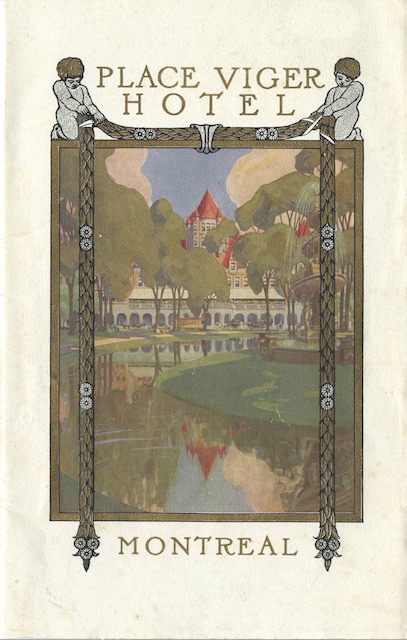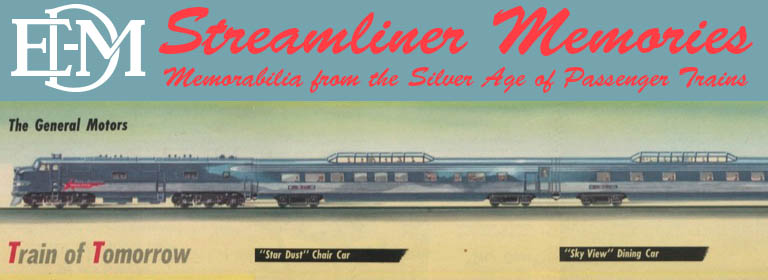Yesterday’s booklet about the York Hotel and its 1,000 rooms raises a question that I have mentioned before: why didn’t Canadian Pacific build a similar hotel in Montreal? Not only was Montreal its headquarters city, it was Canada’s second-largest city with nearly 96 percent as many residents as Toronto. It was also the home port for the company’s empress fleet and — as Canada’s largest French-speaking city — offered the same sort of exotic appeal as Victoria (which has been called Canada’s “most British city“), on the other end of the country.
 Click image to view and download a 24.8-MB PDF of this 20-page booklet from the Chung collection.
Click image to view and download a 24.8-MB PDF of this 20-page booklet from the Chung collection.
As illustrated by the above booklet, the Montreal hotel in Canadian Pacific’s chain was Place Viger, which was built in 1898 and designed by Bruce Price, the architect of the original Chateau Frontenac. As originally built, Place Viger and Chateau Frontenac were both about six stories tall. In 1924, CP added an 18-story tower to the Frontenac, but made no similar additions to Place Viger.
When Place Viger was built, CP already had a train station in Montreal, Windsor Station, that was also designed by Bruce Price and that opened a year before Place Viger. Windsor also served as the company headquarters. Apparently, CP opened Place Viger because it was closer to its docks that would soon be used by its Atlantic empress fleet.
We’ve seen an expression menu featuring the hotel, but I haven’t been able to find an “expression” booklet, which would say how many guest rooms were in the hotel. The above booklet doesn’t say, but I suspect it was around 400 as it could not have been close to the 567 found in the Frontenac after its tower was built.
Like many early transportation centers, the fortunes of the area around Place Viger declined over the years as the city’s main business district migrated to the west, where Windsor Station was already located. In 1935, CP closed Place Viger as both a station and a hotel.
CP was then without a hotel in its headquarters city for more than 30 years. I can understand why it might not build a hotel during the Depression (though it paid half the cost of building the Hotel Vancouver, which opened in 1939), but why did it take until 1967 for it to open the Chateau Champlain in Montreal? This hotel (contrary to the name, it looks more like a cheese grater than a French chateau) has 596 guest rooms, which are 596 rooms it could have sold between World War II and 1967.

(Sorry, my comment disappeared…trying again…)
Your dedication to Canadian transportation history–and knowledge of historical arcana–is extremely impressive! (Speaking as a Canadian who is fascinated by said history.)
One minor detail: Montreal was actually Canada’s *largest* city and metro area for decades, right up until the 1970s. It was as you mentioned a seaport, and also the centre of Canada’s railway system, with multiple trains per day to all major destinations (Halifax, Boston, New York, Washington, Toronto, Detroit, Chicago, Winnipeg, and Vancouver).
It was during the heyday of Quebecois separatism that a population flight occurred (including some major employers), causing Toronto’s population to pull ahead of Montreal’s. Meanwhile, those of us in metro Vancouver had to remain content with our third-place status..
All the more reason to wonder why Canadian Pacific did not have a grand hotel in the great gateway city to Canada!
Our Canadian friend, above, is correct. Until the P.Q. sent a goodly portion of Montreal’s economy down the 401 to Toronto, it was Canada’s laregest economic and population center. It is still a wonderful city that so many of us love.
Thanks for your comments. Montreal may have been bigger than Toronto in recent decades, but Canada’s 1931 census (conducted two years after the York Hotel opened) found 857,000 residents in Toronto and 819,000 in Montreal. It wasn’t until the 1951 census that Montreal was recorded as having more people than Toronto. That didn’t last long as the 1961 census put Toronto ahead again.
Similarly, metropolitan Montreal was ahead of metropolitan Toronto from 1951 through 1971, but since the 1976 census metro Toronto was the biggest. My comments referred to 1929 when the York was built, but you are right that the fact that Montreal was bigger than Toronto in the post-war era makes it even more puzzling that CP didn’t build a hotel there until 1967.